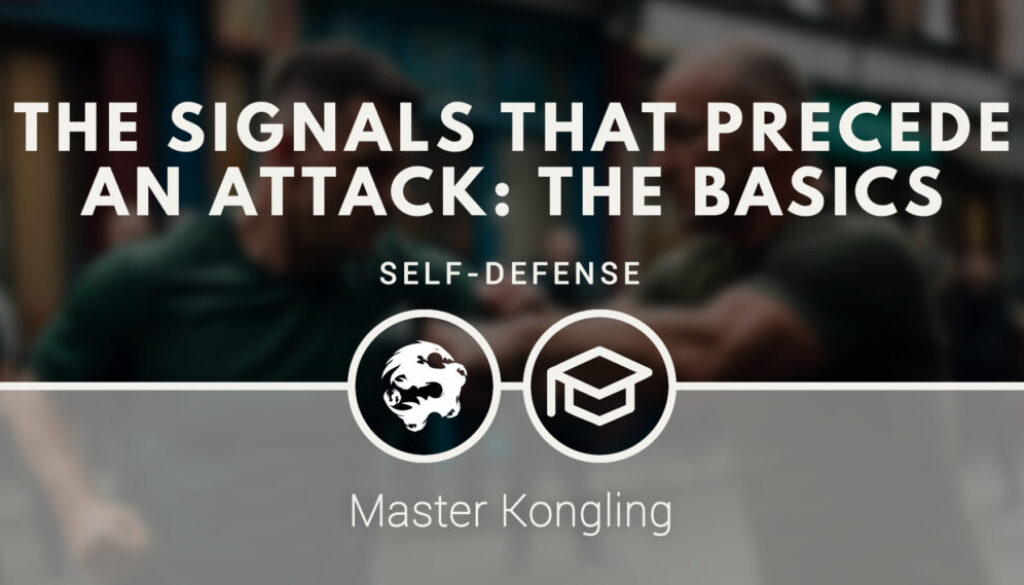The signals that precede an attack: the basics
Recognize the signals of an imminent attack
In 6 Dragons Kung Fu, we distinguish 2 types of “signals” that precede an attack:
- Sudden signals – Typical of a dynamic context (eg. during a fight), they are micro red flags that precede an attack in the shortest time (fractions of a second); without deep practice, they are not easy to notice not so much because of their complexity but rather because of the incredible brevity of the time available to us to assess them
- Contextual signals – Typical of a more “static” context (eg. before a fight), they are instead much more recognizable due to the slower and less chaotic conditions of analysis; it goes therefore by itself that they are within the reach of everyone
Note – This article has been asked by one of our Core Course practitioners on Patreon (see how to attend our home study classes here Learn Kung Fu online: a beginner-to-expert course).
It is obvious that these 2 groups share a small common part but they remain absolutely 2 different fields of study.
A note by Master Kongling – We could say that to spot the signals of the first group is something more related to the deep practice of sparring (read Martial arts sparring [MINI-GUIDE]), for the ones of the second group it is more a theoretical knowledge.
1. The sudden signals
During an evolving combat, the sudden signals are all those (more or less voluntary) micro-movements, small hesitations, or choices forced by physics that can allow us to predict what our adversary is going to do.
It is useless to say that the ability to (correctly) read these sorts of “anticipations” is an overwhelming advantage because gives us the possibility to:
- Not being hit / captured / etc.
- Exploit their instance in our favor
A note by Master Kongling – The problem is that we need a good level of experience, a performant body and a fast mind to: first, recognize the signals (without being deceived by eventual feints), second, choose the right reaction and third, quickly put it into practice (with surgical precision, read also Speed and quickness).
2. The contextual signals
In real self-defense scenarios, the contextual signals are those that (easily) give us the biggest opportunities to exit completely unharmed from potentially lethal situations (read Personal defense: the S.A.F.E. method) and the reason is that:
- In many cases, they can completely prevent physical violence (read What is the difference between real fights and combative sport)
- They may give us the time to get away, to get ready to fight or even to choose to keep quiet (read Self-Defense: 10 things to avoid in a quarrel)
In the next articles of this series, we will see both categories in detail but before we will take a look at the signals that do not necessarily identify a real willingness to attack (read The signals that do not necessarily precede an aggression).
In-depth video courses
- Basic 6 Dragons Kung Fu Exercises – The core practices to build real martial skills
- Advanced speed and reflexes training – How to speed up mind and body to develop combat speed
- Mind self-control hacks – Optimize the functionality of our brain to achieve our goals in fighting and in daily life
- Self-defense: not violent self-preservation – Everything we can (should) do before fighting
- Self-defense basics: how to – The full path to self-defense of our school
In-depth articles
- Study an opponent to use his errors – How to scan the adversary’s behavior and exploit them
- Self-defense: aggression in front of a supermarket – A real self-defense scenario solved without recurring to violence
Questions
Reply in the comments and share your experience:
- Do you feel able to read the sudden signals of attack of an opponent?
Author: Master Kongling
Founder of 6 Dragons Kung Fu.How to master 6 Dragons Kung Fu?
Are you searching for:
- Daily training exercises?
- Synthetic theory and concepts?
- A step by step path from white to black belt?
- A path (clear, consequential and gradual) designed to build real martial skills?
- A direct contact with Master Kongling?
Go to our Patreon page and choose a training plan: starting from the Practitioner level, you will gain access to all this and much more.
Inside each Premium Lesson, you will receive the same teaching (practices, tips, concepts, small secrets and corrections) reserved to the live students of Master Kongling.
Important - Once a certain number of registrations are reached, no other participants can be accepted. For more information write to: [email protected].










December 21, 2017 @ 11:21 pm
The present results, considered in conjunction with this previous work, suggest that though the occurrence of big attacks appears scattered somewhat randomly over the course of a group’s lifespan, the set of small-scale attacks that precede these big attacks has a more systematic pattern.
December 22, 2017 @ 5:12 pm
What do you mean?
February 13, 2022 @ 1:21 am
How can I understand from the eyes when the enemy will attack?
February 13, 2022 @ 8:15 am
It depends on the scenario but it is not easy at all for a beginner, you need experience and a trained mind. In many cases, what you should do is to control where the hands / feet are what they could do and what they are doing. In many cases, this is more than enough.
June 5, 2023 @ 3:25 pm
Can you update this thankss
January 15, 2025 @ 10:10 pm
Updated!